Search
- Page Path
- HOME > Search
- [Korean]
- A Study on the Microstructure and Magnetic Properties of Fe83.2Si5.33-0.33
x B10.67-0.67x Px Cu0.8 Nanocrystalline Soft Magnetic Alloys with varying P Content - Hyun Ah Im, Kyoung-Hoon Bae, Yeong gyun Nam, Subong An, Sangsun Yang, Yong-Jin Kim, Jung Woo Lee, Jae Won Jeong
- J Korean Powder Metall Inst. 2021;28(4):293-300. Published online August 1, 2021
- DOI: https://doi.org/10.4150/KPMI.2021.28.4.293

- 742 View
- 9 Download
-
 Abstract
Abstract
 PDF
PDF We investigate the effect of phosphorous content on the microstructure and magnetic properties of Fe83.2Si5.33-0.33
x B10.67-0.67x Px Cu0.8 (x = 1–4 at.%) nanocrystalline soft magnetic alloys. The simultaneous addition of Cu and P to nanocrystalline alloys reportedly decreases the nanocrystalline size significantly, to 10–20 nm. In the P-containing nanocrystalline alloy, P atoms are distributed in an amorphous residual matrix, which suppresses grain growth, increases permeability, and decreases coercivity. In this study, nanocrystalline ribbons with a composition of Fe83.2Si5.33-0.33x B10.67- 0.67x Px Cu0.8 (x = 1–4 at.%) are fabricated by rapid quenching melt-spinning and thermal annealing. It is demonstrated that the addition of a small amount of P to the alloy improves the glass-forming ability and increases the resistance to undesirable Fex(B,P) crystallization. Among the alloys investigated in this work, an Fe83.2Si5B10P1Cu0.8 nanocrystalline ribbon annealed at 460°C exhibits excellent soft-magnetic properties including low coercivity, low core loss, and high saturation magnetization. The uniform nanocrystallization of the Fe83.2Si5B10P1Cu0.8 alloy is confirmed by high-resolution transmission electron microscopy analysis.
- [Korean]
- Spheroidization of Enamel Powders by Radio Frequency Plasma Treatment and Application to Additive Manufacturing
- Ki-Bong Kim, Dong-Yeol Yang, Yong-Jin Kim, Jungho Choe, Ji-Na Kwak, Woo-Hyung Jung
- J Korean Powder Metall Inst. 2020;27(5):388-393. Published online October 1, 2020
- DOI: https://doi.org/10.4150/KPMI.2020.27.5.388

- 630 View
- 3 Download
-
 Abstract
Abstract
 PDF
PDF The enamel powders used traditionally in Korea are produced by a ball-milling process. Because of their irregular shapes, enamel powders exhibit poor flowability. Therefore, polygonal enamel powders are only used for handmade cloisonné crafts. In order to industrialize or automate the process of cloisonné crafts, it is essential to control the size and shape of the powder. In this study, the flowability of the enamel powders was improved using the spheroidization process, which employs the RF plasma treatment. In addition, a simple grid structure and logo were successfully produced using the additive manufacturing process (powder bed fusion), which utilizes spherical enamel powders. The additive manufacturing technology of spherical enamel powders is expected to be widely used in the field of cloisonné crafting in the future.
- [Korean]
- A study about sculpture characteristic of SKD61 tool steel fabricated by selective laser melting(SLM) process
- Jaecheol Yun, Jungho Choe, Ki-Bong Kim, Sangsun Yang, Dong-Yeol Yang, Yong-Jin Kim, Chang-Woo Lee, Chang-Woo Lee
- J Korean Powder Metall Inst. 2018;25(2):137-143. Published online April 1, 2018
- DOI: https://doi.org/10.4150/KPMI.2018.25.2.137
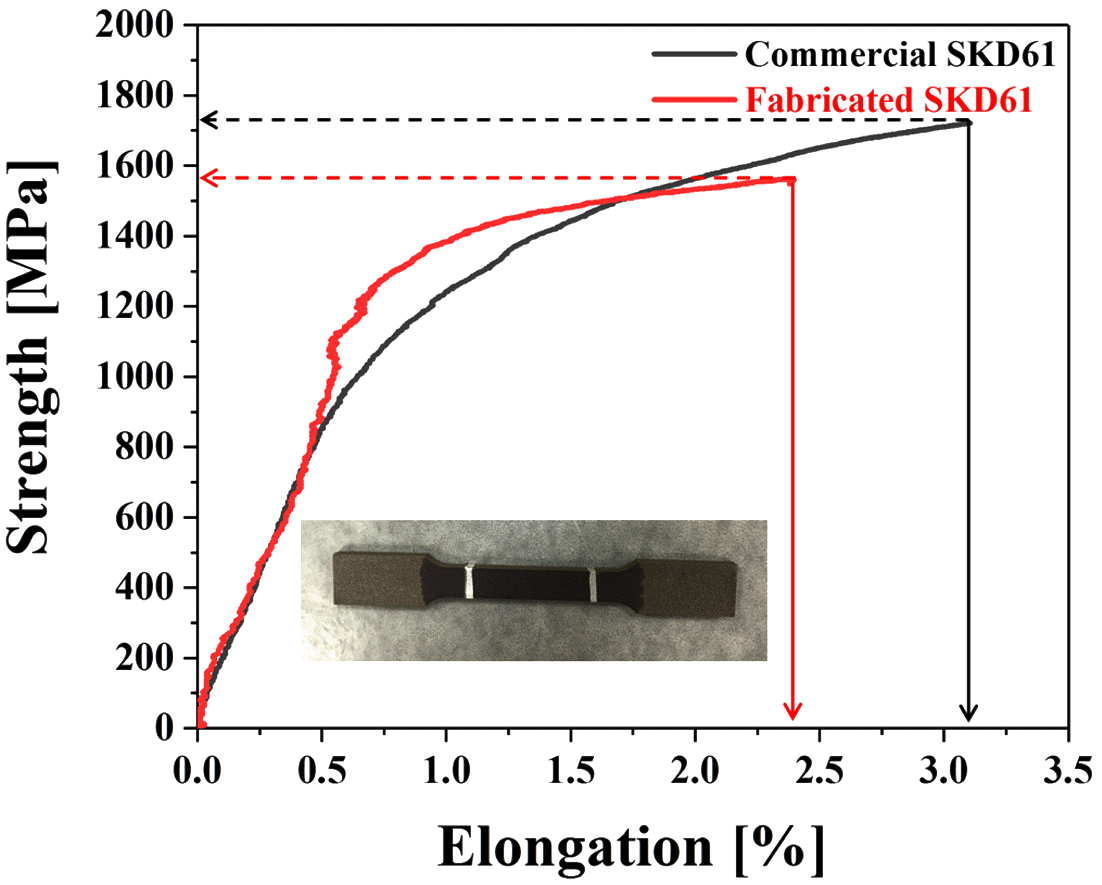
- 926 View
- 3 Download
- 1 Citations
-
 Abstract
Abstract
 PDF
PDF In this study, two types of SKD61 tool-steel samples are built by a selective laser melting (SLM) process using the different laser scan speeds. The characteristics of two kinds of SKD61 tool-steel powders used in the SLM process are evaluated. Commercial SKD61 tool-steel power has a flowability of 16.68 sec/50 g and its Hausner ratio is calculated to be 1.25 by apparent and tapped density. Also, the fabricated SKD61 tool steel powder fabricated by a gas atomization process has a flowability of 21.3 sec/50 g and its Hausner ratio is calculated to be 1.18. Therefore, we confirmed that the two powders used in this study have excellent flowability. Samples are fabricated to measure mechanical properties. The highest densities of the SKD61 tool-steel samples, fabricated under the same conditions, are 7.734 g/cm3 (using commercial SKD61 powder) and 7.652 g/cm3 (using fabricated SKD61 powder), measured with Archimedes method. Hardness is measured by Rockwell hardness testing equipment 5 times and the highest hardnesses of the samples are 54.56 HRC (commercial powder) and 52.62 HRC (fabricated powder). Also, the measured tensile strengths are approximately 1,721 MPa (commercial SKD61 powder) and 1,552 MPa (fabricated SKD61 powder), respectively.
-
Citations
Citations to this article as recorded by- Microstructural effects on the tensile and fracture behavior of selective laser melted H13 tool steel under varying conditions
Jungsub Lee, Jungho Choe, Junhyeok Park, Ji-Hun Yu, Sangshik Kim, Im Doo Jung, Hyokyung Sung
Materials Characterization.2019; 155: 109817. CrossRef
- Microstructural effects on the tensile and fracture behavior of selective laser melted H13 tool steel under varying conditions
- [English]
- Synthesis of Boron Nitride Nanotubes via inductively Coupled thermal Plasma process Catalyzed by Solid-state ammonium Chloride
- Mi Se Chang, Young Gyun Nam, Sangsun Yang, Kyung Tae Kim, Ji Hun Yu, Yong-Jin Kim, Jae Won Jeong
- J Korean Powder Metall Inst. 2018;25(2):120-125. Published online April 1, 2018
- DOI: https://doi.org/10.4150/KPMI.2017.25.2.120
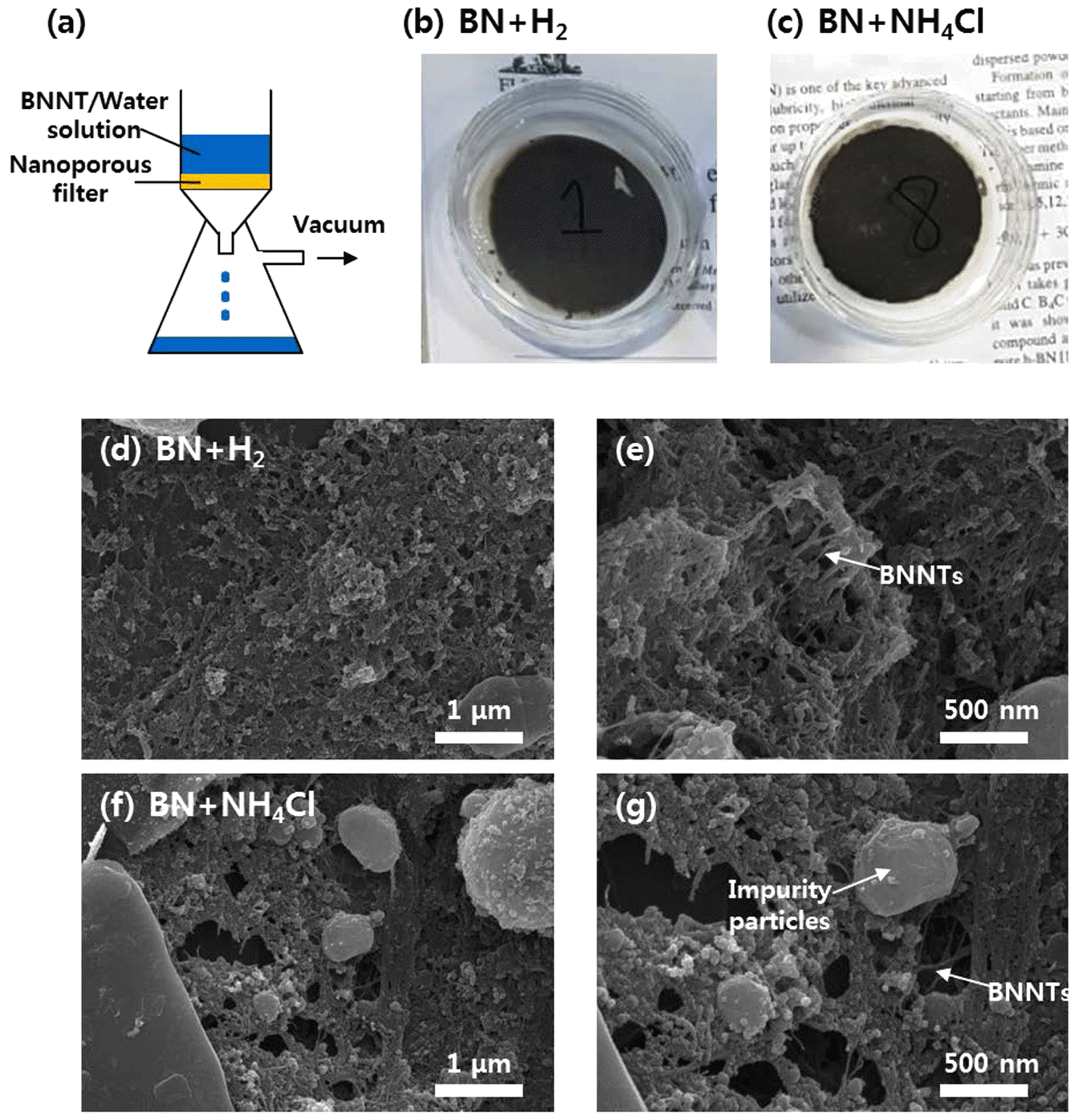
- 544 View
- 5 Download
-
 Abstract
Abstract
 PDF
PDF Boron nitride nanotubes (BNNTs) are receiving great attention because of their unusual material properties, such as high thermal conductivity, mechanical strength, and electrical resistance. However, high-throughput and highefficiency synthesis of BNNTs has been hindered due to the high boiling point of boron (~ 4000°C) and weak interaction between boron and nitrogen. Although, hydrogen-catalyzed plasma synthesis has shown potential for scalable synthesis of BNNTs, the direct use of H2 gas as a precursor material is not strongly recommended, as it is extremely flammable. In the present study, BNNTs have been synthesized using radio-frequency inductively coupled thermal plasma (RF-ITP) catalyzed by solid-state ammonium chloride (NH4Cl), a safe catalyst materials for BNNT synthesis. Similar to BNNTs synthesized from h-BN (hexagonal boron nitride) + H2, successful fabrication of BNNTs synthesized from h-BN+NH4Cl is confirmed by their sheet-like properties, FE-SEM images, and XRD analysis. In addition, improved dispersion properties in aqueous solution are found in BNNTs synthesized from h-BN +NH4Cl.
- [Korean]
- A Study on the Wear Properties of Cu-free Ecofriendly Vehicle Brake Pad
- Ki-Bong Kim, Sangsun Yang, Seong-Ju Lee, Suk-Hun Hwang, Sin-Wook Kim, Yong-Jin Kim
- J Korean Powder Metall Inst. 2018;25(1):30-35. Published online February 1, 2018
- DOI: https://doi.org/10.4150/KPMI.2018.25.1.30
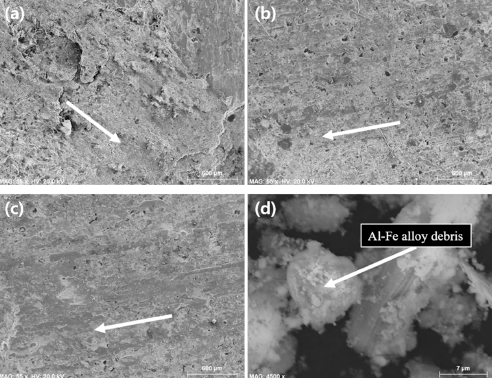
- 527 View
- 4 Download
-
 Abstract
Abstract
 PDF
PDF The friction characteristics of Al-Fe alloy powders are investigated in order to develop an eco-friendly friction material to replace Cu fiber, a constituent of brake-pad friction materials. Irregularly shaped Al-Fe alloy powders, prepared by gas atomization, are more uniformly dispersed than conventional Cu fiber on the brake pad matrix. The wear rate of the friction material using Al-8Fe alloy powder is lower than that of the Cu fiber material. The change in friction coefficient according to the friction lap times is 7.2% for the Cu fiber, but within 3.8% for the Al-Fe alloy material, which also shows excellent judder characteristics. The Al-Fe alloy powders are uniformly distributed in the brake pad matrix and oxide films of Al and Fe are homogeneously formed at the friction interface between the disc and pad, thus exhibiting excellent friction and lubrication characteristics. The brake pad containing Al-Fe powders avoids contamination by Cu dust, which is generated during braking, by replacing the Cu fiber while maintaining the friction and lubrication performance.
- [Korean]
- Investigation on Fe-Hf-B-Nb-P-C Soft Magnetic Powders Prepared by High-Pressure Gas Atomization
- Jae Won Jeong, Dong-Yeol Yang, Ki Bong Kim, Junhong Lee, Young Ja Kim, Tae-Soo Lim, Sangsun Yang, Min Ha Lee, Hwi Jun Kim, Yong-Jin Kim
- J Korean Powder Metall Inst. 2016;23(5):391-396. Published online October 1, 2016
- DOI: https://doi.org/10.4150/KPMI.2016.23.5.391
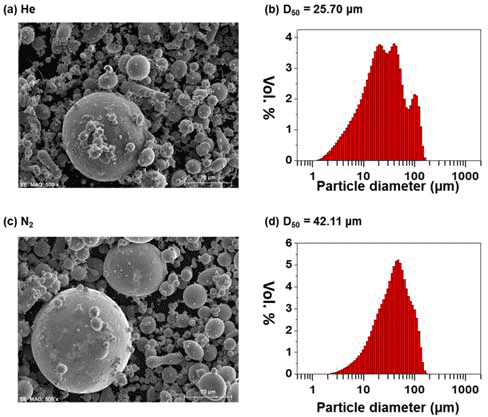
- 695 View
- 1 Download
- 3 Citations
-
 Abstract
Abstract
 PDF
PDF In this study, ultra-fine soft-magnetic micro-powders are prepared by high-pressure gas atomization of an Fe-based alloy, Fe-Hf-B-Nb-P-C. Spherical powders are successfully obtained by disintegration of the alloy melts under high-pressure He or N2 gas. The mean particle diameter of the obtained powders is 25.7 μm and 42.1 μm for He and N2 gas, respectively. Their crystallographic structure is confirmed to be amorphous throughout the interior when the particle diameter is less than 45 μm. The prepared powders show excellent soft magnetic properties with a saturation magnetization of 164.5 emu/g and a coercivity of 9.0 Oe. Finally, a toroidal core is fabricated for measuring the magnetic permeability, and a μr of up to 78.5 is obtained. It is strongly believed that soft magnetic powders prepared by gas atomization will be beneficial in the fabrication of high-performance devices, including inductors and motors.
-
Citations
Citations to this article as recorded by- Optimization of Densification Behavior of a Soft Magnetic Powder by Discrete Element Method and Machine Learning
Jungjoon Kim, Dongchan Min, Suwon Park, Junhyub Jeon, Seok-Jae Lee, Youngkyun Kim, Hwi-Jun Kim, Youngjin Kim, Hyunjoo Choi
MATERIALS TRANSACTIONS.2022; 63(10): 1304. CrossRef - Optimizing the magnetic properties of Fe-based amorphous powder by adjusting atomic structures from vitrification at different temperatures
Song-Yi Kim, Hye-Ryeong Oh, Hyeon-Ah Kim, A-Young Lee, Hwi-Jun Kim, Sang-Sun Yang, Yong-Jin Kim, Hyun-Joo Choi, Il-Hyun Kim, Hyun-Gil Kim, Jürgen Eckert, Jong-Ryoul Kim, Min-Ha Lee
Journal of Applied Physics.2019;[Epub] CrossRef - Soft magnetic properties of Fe-based amorphous/nanocrystalline hybrid materials
Yeonjoo Lee, Jonggyu Jeon, Seungjin Nam, Teasuk Jang, Hwijun Kim, Minwoo Lee, Yongjin Kim, Dongyeol Yang, Kyeongsik Min, Hyunjoo Choi
Powder Technology.2018; 339: 440. CrossRef
- Optimization of Densification Behavior of a Soft Magnetic Powder by Discrete Element Method and Machine Learning
- [Korean]
- Microstructures of Powders and Additively Manufactured Objects of an Alloy Tool Steel for Cold-Work Dies
- Jun-Yun Kang, Jaecheol Yun, Hoyoung Kim, Byunghwan Kim, Jungho Choe, Sangsun Yang, Ji-Hun Yu, Yong-Jin Kim
- J Korean Powder Metall Inst. 2016;24(3):202-209. Published online June 1, 2016
- DOI: https://doi.org/10.4150/KPMI.2017.24.3.202

- 778 View
- 1 Download
- 3 Citations
-
 Abstract
Abstract
 PDF
PDF A cold-work tool steel powder is used to fabricate 3-dimensional objects by selective laser melting using a high-pressure gas atomization process. The spherical powder particles form continuous carbide networks among the austenite matrix and its decomposition products. The carbides comprise Nb-rich MC and Mo-rich M2C. In the SLM process, the process parameters such as the laser power (90 W), layer thickness (25 μm), and hatch spacing (80 μm) are kept fixed, while the scan speed is changed from 50 mm/s to 4000 mm/s. At a low scan speed of 50 mm/s, spherical cavities develop due to over melting, while they are substantially reduced on increasing the speed to 2000 mm/s. The carbide network spacing decreases with increasing speed. At an excessively high speed of 4000 mm/s, long and irregularly shaped cavities are developed due to incomplete melting. The influence of the scan pattern is examined, for which 1 × 1 mm2 blocks constituting a processing layer are irradiated in a random sequence. This island-type pattern exhibits the same effect as that of a low scan speed. Post processing of an object using hot isostatic pressing leads to a great reduction in the porosity but causes coarsening of the microstructure.
-
Citations
Citations to this article as recorded by- Nanoindentation Creep Behavior of Additively Manufactured H13 Steel by Utilizing Selective Laser Melting Technology
Evangelos Giarmas, Emmanouil K. Tzimtzimis, Nikolaos Kladovasilakis, Dimitrios Tzovaras, Dimitrios Tzetzis
Materials.2024; 17(15): 3756. CrossRef - Micro-Texture Analyses of a Cold-Work Tool Steel for Additive Manufacturing
Jun-Yun Kang, Jaecheol Yun, Byunghwan Kim, Jungho Choe, Sangsun Yang, Seong-Jun Park, Ji-Hun Yu, Yong-Jin Kim
Materials.2020; 13(3): 788. CrossRef - Microstructural effects on the tensile and fracture behavior of selective laser melted H13 tool steel under varying conditions
Jungsub Lee, Jungho Choe, Junhyeok Park, Ji-Hun Yu, Sangshik Kim, Im Doo Jung, Hyokyung Sung
Materials Characterization.2019; 155: 109817. CrossRef
- Nanoindentation Creep Behavior of Additively Manufactured H13 Steel by Utilizing Selective Laser Melting Technology
- [Korean]
- Mechanical Property Improvement of the H13 Tool Steel Sculptures Built by Metal 3D Printing Process via Optimum Conditions
- Jaecheol Yun, Jungho Choe, Haengna Lee, Ki-Bong Kim, Sangsun Yang, Dong-Yeol Yang, Yong-Jin Kim, Chang-Woo Lee, Ji-Hun Yu
- J Korean Powder Metall Inst. 2016;24(3):195-201. Published online June 1, 2016
- DOI: https://doi.org/10.4150/KPMI.2017.24.3.195
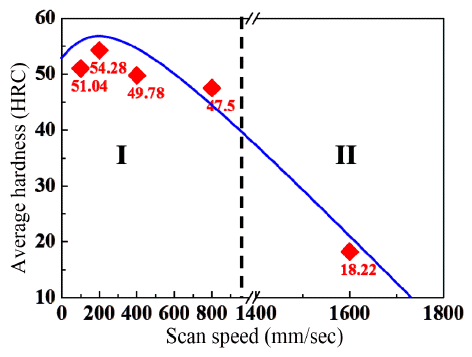
- 1,037 View
- 10 Download
- 7 Citations
-
 Abstract
Abstract
 PDF
PDF In this study, H13 tool steel sculptures are built by a metal 3D printing process at various laser scan speeds. The properties of commercial H13 tool steel powders are confirmed for the metal 3D printing process used: powder bed fusion (PBF), which is a selective laser melting (SLM) process. Commercial H13 powder has an excellent flowability of 16.68 s/50 g with a Hausner ratio of 1.25 and a density of 7.68 g/cm3. The sculptures are built with dimensions of 10 × 10 × 10 mm3 in size using commercial H13 tool steel powder. The density measured by the Archimedes method is 7.64 g/cm3, similar to the powder density of 7.68 g/cm3. The hardness is measured by Rockwell hardness equipment 5 times to obtain a mean value of 54.28 HRC. The optimum process conditions in order to build the sculptures are a laser power of 90 W, a layer thickness of 25 μm, an overlap of 30%, and a laser scan speed of 200 mm/s.
-
Citations
Citations to this article as recorded by- Spheroidization of Enamel Powders by Radio Frequency Plasma Treatment and Application to Additive Manufacturing
Ki-Bong Kim, Dong-Yeol Yang, Yong-Jin Kim, Jungho Choe, Ji-Na Kwak, Woo-Hyung Jung
Journal of Korean Powder Metallurgy Institute.2020; 27(5): 388. CrossRef - Microstructural effects on the tensile and fracture behavior of selective laser melted H13 tool steel under varying conditions
Jungsub Lee, Jungho Choe, Junhyeok Park, Ji-Hun Yu, Sangshik Kim, Im Doo Jung, Hyokyung Sung
Materials Characterization.2019; 155: 109817. CrossRef - Nano-mechanical Behavior of H13 Tool Steel Fabricated by a Selective Laser Melting Method
Van Luong Nguyen, Eun-ah Kim, Jaecheol Yun, Jungho Choe, Dong-yeol Yang, Hak-sung Lee, Chang-woo Lee, Ji-Hun Yu
Metallurgical and Materials Transactions A.2019; 50(2): 523. CrossRef - Correlation between Microstructure and Mechanical Properties of the Additive Manufactured H13 Tool Steel
Woojin An, Junhyeok Park, Jungsub Lee, Jungho Choe, Im Doo Jung, Ji-Hun Yu, Sangshik Kim, Hyokyung Sung
Korean Journal of Materials Research.2018; 28(11): 663. CrossRef - Evaluation of Strain-Rate Sensitivity of Selective Laser Melted H13 Tool Steel Using Nanoindentation Tests
Van Luong Nguyen, Eun-ah Kim, Seok-Rok Lee, Jaecheol Yun, Jungho Choe, Dong-yeol Yang, Hak-sung Lee, Chang-woo Lee, Ji-Hun Yu
Metals.2018; 8(8): 589. CrossRef - Comparison of Nano-Mechanical Behavior between Selective Laser Melted SKD61 and H13 Tool Steels
Jaecheol Yun, Van Luong Nguyen, Jungho Choe, Dong-Yeol Yang, Hak-Sung Lee, Sangsun Yang, Ji-Hun Yu
Metals.2018; 8(12): 1032. CrossRef - A study about sculpture characteristic of SKD61 tool steel fabricated by selective laser melting(SLM) process
Jaecheol Yun, Jungho Choe, Ki-Bong Kim, Sangsun Yang, Dong-Yeol Yang, Yong-Jin Kim, Chang-Woo Lee, Chang-Woo Lee
Journal of Korean Powder Metallurgy Institute.2018; 25(2): 137. CrossRef
- Spheroidization of Enamel Powders by Radio Frequency Plasma Treatment and Application to Additive Manufacturing
- [Korean]
- The Influence of a Single Melt Pool Morphology on Densification Behavior of Three-Dimensional Structure Fabricated by Additive Manufacturing
- Jungho Choe, Jaecheol Yun, Dong-Yeol Yang, Sangsun Yang, Ji-Hun Yu, Chang-Woo Lee, Yong-Jin Kim
- J Korean Powder Metall Inst. 2016;24(3):187-194. Published online June 1, 2016
- DOI: https://doi.org/10.4150/KPMI.2017.24.3.187
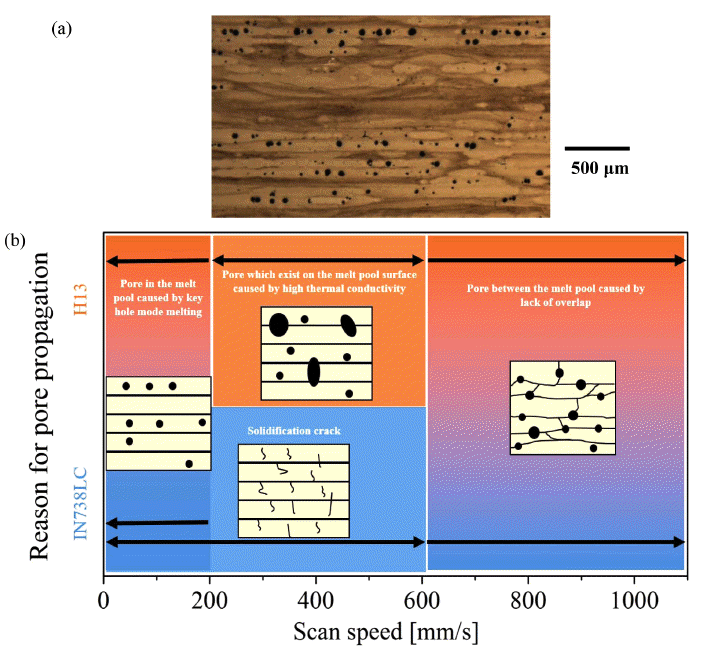
- 753 View
- 2 Download
- 5 Citations
-
 Abstract
Abstract
 PDF
PDF Selective laser melting (SLM) can produce a layer of a metal powder and then fabricate a three-dimensional structure by a layer-by-layer method. Each layer consists of several lines of molten metal. Laser parameters and thermal properties of the materials affect the geometric characteristics of the melt pool such as its height, depth, and width. The geometrical characteristics of the melt pool are determined herein by optical microscopy and three-dimensional bulk structures are fabricated to investigate the relationship between them. Powders of the commercially available Fe-based tool steel AISI H13 and Ni-based superalloy Inconel 738LC are used to investigate the effect of material properties. Only the scan speed is controlled to change the laser parameters. The laser power and hatch space are maintained throughout the study. Laser of a higher energy density is seen to melt a wider and deeper range of powder and substrate; however, it does not correspond with the most highly densified three-dimensional structure. H13 shows the highest density at a laser scan speed of 200 mm/s whereas Inconel 738LC shows the highest density at 600 mm/s.
-
Citations
Citations to this article as recorded by- Microstructural effects on the tensile and fracture behavior of selective laser melted H13 tool steel under varying conditions
Jungsub Lee, Jungho Choe, Junhyeok Park, Ji-Hun Yu, Sangshik Kim, Im Doo Jung, Hyokyung Sung
Materials Characterization.2019; 155: 109817. CrossRef - Correlation between Microstructure and Mechanical Properties of the Additive Manufactured H13 Tool Steel
Woojin An, Junhyeok Park, Jungsub Lee, Jungho Choe, Im Doo Jung, Ji-Hun Yu, Sangshik Kim, Hyokyung Sung
Korean Journal of Materials Research.2018; 28(11): 663. CrossRef - Effect of Porosity on Mechanical Anisotropy of 316L Austenitic Stainless Steel Additively Manufactured by Selective Laser Melting
Jeong Min Park, Jin Myoung Jeon, Jung Gi Kim, Yujin Seong, Sun Hong Park, Hyoung Seop Kim
Journal of Korean Powder Metallurgy Institute.2018; 25(6): 475. CrossRef - Evaluation of the Accuracy of Dental Prostheses manufactured by Metal 3D Printer
Junho Hwang, Yun-Ho Kim, Hyun-Deok Kim, Kyu-Bok Lee
Journal of Welding and Joining.2018; 36(5): 70. CrossRef - A study about sculpture characteristic of SKD61 tool steel fabricated by selective laser melting(SLM) process
Jaecheol Yun, Jungho Choe, Ki-Bong Kim, Sangsun Yang, Dong-Yeol Yang, Yong-Jin Kim, Chang-Woo Lee, Chang-Woo Lee
Journal of Korean Powder Metallurgy Institute.2018; 25(2): 137. CrossRef
- Microstructural effects on the tensile and fracture behavior of selective laser melted H13 tool steel under varying conditions
- [Korean]
- Investigation on the Sintering Behavior and Mechanical Properties of Al-Zn-Mg Alloy Powders Mixed with Al-Si-SiC Composite Powders
- Gwang-Joo Jang, Kyung Tae Kim, Sangsun Yang, Yong-Jin Kim, Yong-Ho Park
- J Korean Powder Metall Inst. 2014;21(6):460-466. Published online December 1, 2014
- DOI: https://doi.org/10.4150/KPMI.2014.21.6.460
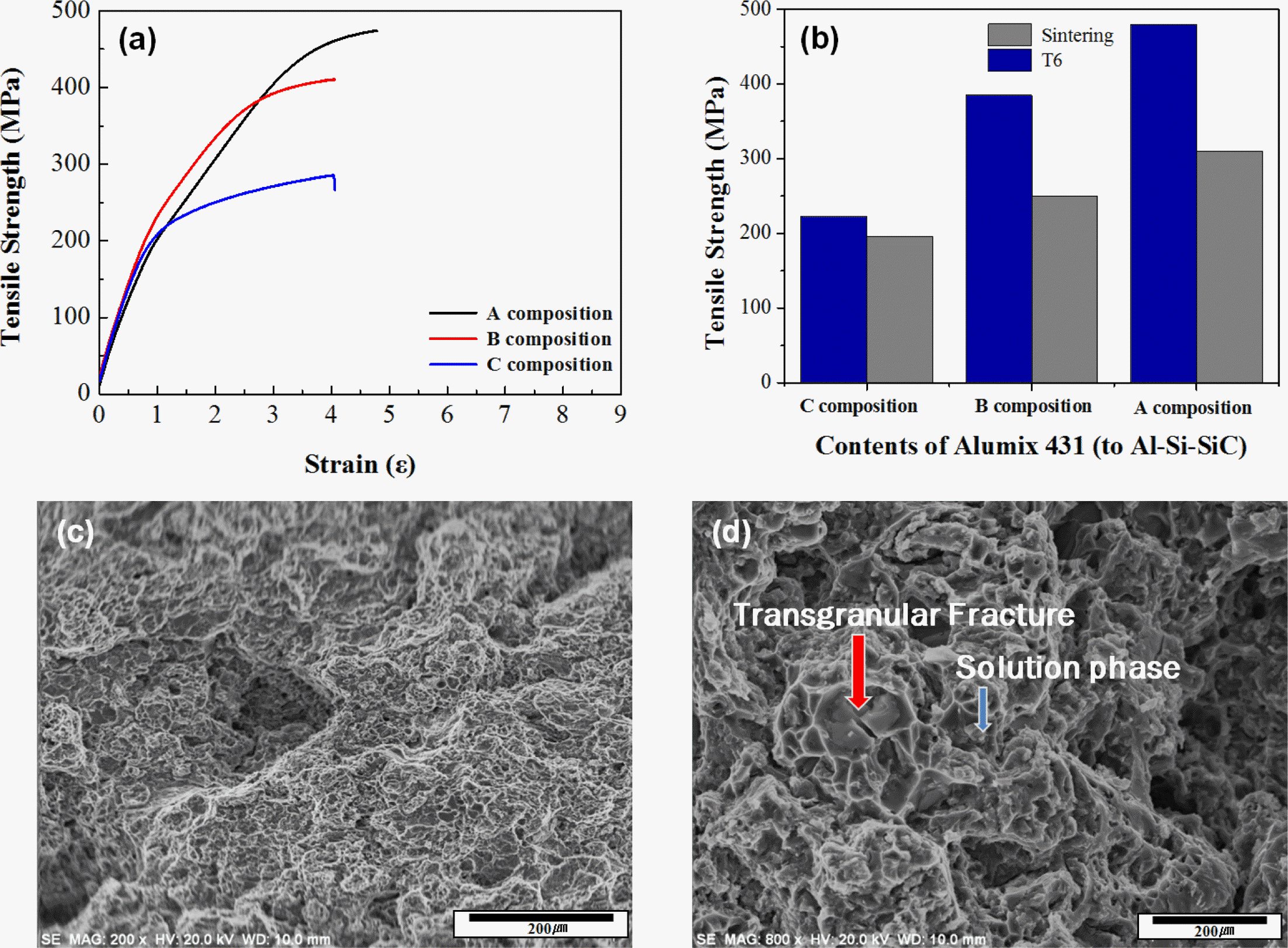
- 731 View
- 2 Download
- 1 Citations
-
 Abstract
Abstract
 PDF
PDF Al-Si-SiC composite powders with intra-granular SiC particles were prepared by a gas atomization process. The composite powders were mixed with Al-Zn-Mg alloy powders as a function of weight percent. Those mixture powders were compacted with the pressure of 700 MPa and then sintered at the temperature of 565-585°C. T6 heat treatment was conducted to increase their mechanical properties by solid-solution precipitates. Each relative density according to the optimized sintering temperature of those powders were determined as 96% at 580°C for Al-Zn-Mg powders (composition A), 97.9% at 575°C for Al-Zn-Mg powders with 5 wt.% of Al-Si-SiC powders (composition B), and 98.2% at 570°C for Al-Zn-Mg powders with 10 wt.% of Al-Si-SiC powders (composition C), respectively. Each hardness, tensile strength, and wear resistance test of those sintered samples was conducted. As the content of Al-Si-SiC powders increased, both hardness and tensile strength were decreased. However, wear resistance was increased by the increase of Al-Si-SiC powders. From these results, it was confirmed that Al-Si-SiC/Al-Zn-Mg composite could be highly densified by the sintering process, and thus the composite could have high wear resistance and tensile strength when the content of Al-Si-SiC composite powders were optimized.
-
Citations
Citations to this article as recorded by- Effect of Tin Addition on the Melting Temperatures and Mechanical Properties of Al-Si-Cu Brazing Filler Metals
Min Sang Kim, Chun Woong Park, Jong Min Byun, Young Do Kim
Korean Journal of Materials Research.2016; 26(7): 376. CrossRef
- Effect of Tin Addition on the Melting Temperatures and Mechanical Properties of Al-Si-Cu Brazing Filler Metals
- [Korean]
- Preparation of Metal Injection Molded Dental Components using Spheroidized Ti Powders by Plasma Process
- Ji-Na Gwak, Sangsun Yang, Jung-Yeul Yun, Ju-Yong Kim, Seongjin Park, Hyun-Seung Kim, Yong-Jin Kim, Yong-Ho Park
- J Korean Powder Metall Inst. 2013;20(6):467-473.
- DOI: https://doi.org/10.4150/KPMI.2013.20.6.467

- 687 View
- 1 Download
- 2 Citations
-
 Abstract
Abstract
 PDF
PDF - This research presents a preparation method of dental components by metal injection molding process (MIM process) using titanium scrap. About 20µm sized spherical titanium powders for MIM process were successfully prepared by a novel dehydrogenation and spheroidization method using in-situ radio frequency thermal plasma treatment. The effects of MIM process parameters on the mechanical and biological properties of dental components were investigated and the optimum condition was obtained. After sintering at 1250°C for 1 hour in vacuum, the hardness and the tensile strength of MIMed titanium components were 289 Hv and 584 MPa, respectively. Prepared titanium dental components were not cytotoxic and they showed a good cell proliferation property.
-
Citations
Citations to this article as recorded by- Effect of Heat Treatment Temperature and Atmosphere on the Microstructure of TiH2-WO3 Powder Mixtures
Han-Eol Lee, Yeon Su Kim, Sung-Tag Oh
Journal of Korean Powder Metallurgy Institute.2017; 24(1): 41. CrossRef - Characterization Of The Graded Microstructure In Powder Sintered Porous Titanium
J.-J. Oak, J.I. Bang, K.-C. Bae, Y.H. Kim, Y.-C. Lee, H.H. Chun, Y.H. Park
Archives of Metallurgy and Materials.2015; 60(2): 1265. CrossRef
- Effect of Heat Treatment Temperature and Atmosphere on the Microstructure of TiH2-WO3 Powder Mixtures
- [Korean]
- Influence of Particle Size Distribution on Green and Sintered Properties of Fe-Cr-Mo Prealloy Powder
- Ki-Bong Kim, Sangsun Yang, Yong-Jin Kim, Yong-Ho Park
- J Korean Powder Metall Inst. 2013;20(1):7-12.
- DOI: https://doi.org/10.4150/KPMI.2013.20.1.007

- 651 View
- 2 Download
- 2 Citations
-
 Abstract
Abstract
 PDF
PDF - The effect of particle size distribution on green and sintered properties of Fe-Cr-Mo prealloy powder was investigated in this study. For the study, prealloyed Fe-Cr-Mo powders with different particle sizes were mixed as various ratios and cold compacted at various pressure and sintered at 1250°C for 30 min, 90%N_2+10%H_2 atmosphere in the continuous sintering furnace. The results shows that the powders with large particle size distribution have high compressibility and low ejection force. However the green strength are much less than those with small particle size distribution. Tensile prperties of the sintered specimes with large particles size also have high strength and elongation.
-
Citations
Citations to this article as recorded by- The Effects of MoS2Addition on the Mechanical Properties of Fe-Cr-Mn-C-V P/M Alloy
Geon-Hong Kim, Hyun Seok Yang, Man-Sik Kong
Journal of Korean Powder Metallurgy Institute.2014; 21(4): 294. CrossRef - Investigation on the Sintering Behavior and Mechanical Properties of Al-Zn-Mg Alloy Powders Mixed with Al-Si-SiC Composite Powders
Gwang-Joo Jang, Kyung Tae Kim, Sangsun Yang, Yong-Jin Kim, Yong-Ho Park
Journal of Korean Powder Metallurgy Institute.2014; 21(6): 460. CrossRef
- The Effects of MoS2Addition on the Mechanical Properties of Fe-Cr-Mn-C-V P/M Alloy
- [Korean]
- Synthesis of Al/AlN Composites by Mechanical Alloying and the Effect of PCA on Their Properties
- Seok-Hyeoun Kim, Yong-Jin Kim, Jung-Ho Ahn
- J Korean Powder Metall Inst. 2011;18(3):238-243.
- DOI: https://doi.org/10.4150/KPMI.2011.18.3.238

- 405 View
- 0 Download
-
 Abstract
Abstract
 PDF
PDF - Al/AlN composites were synthesized by mechanical alloying using process control agents(PCAs). Three different PCAs which contain N element, were examined to see the effectiveness of ball-milling and the nitridation during sintering. Among examined PCAs, C_8H_6N_4O_5 was the most effective to facilitate ball-milling and to form nitrides during a subsequent sintering. By a proper control of ball-milling and sintering, we could obtained surface-hardened Al-based composites.
- [Korean]
- Synthesis of Yttrium Oxide Nanowire by Hydrothermal Method
- Kyung-Ki Kim, Yong-Jin Kim, Jung-Ho Ahn
- J Korean Powder Metall Inst. 2011;18(1):73-77.
- DOI: https://doi.org/10.4150/KPMI.2011.18.1.073

- 566 View
- 0 Download
- 1 Citations
-
 Abstract
Abstract
 PDF
PDF - Y(OH)_3 nanowires were synthesized by a hydrothermal reaction of metallic Y with aqueous solution of LiOH. The morphology and the size of the nanowires changed with varying the volume of the LiOH solution inside the autoclave. Y(OH)_3 nanowires transformed to Y_2O_3 by a subsequent heat-treatment without morphological change. By a proper control of hydrothermal reaction parameter and heat-treatment, the yield of pure Y_2O_3 nanowires up to 97% was attained.
-
Citations
Citations to this article as recorded by- Synthesis and Characterization of SnO2-CoO/carbon-coated CoO Core/shell Nanowire Composites
Yu-Jin Lee, Bon-Ryul Koo, Hyo-Jin Ahn
Journal of Korean Powder Metallurgy Institute.2014; 21(5): 360. CrossRef
- Synthesis and Characterization of SnO2-CoO/carbon-coated CoO Core/shell Nanowire Composites
- [Korean]
- Preparation of Ultrafine C/N Controled TiCxNy Powders by Magnesium Reduction
- Dong-Won Lee, Byoung-Kee Kim, Jung-Yeul Yun, Ji-Hoon Yu, Yong-Jin Kim
- J Korean Powder Metall Inst. 2010;17(2):142-147.
- DOI: https://doi.org/10.4150/KPMI.2010.17.2.142

- 675 View
- 0 Download
- 1 Citations
-
 Abstract
Abstract
 PDF
PDF - The ultrafine titanium carbonitride (TiC_xN_y) particles below 100 nm in mean size, including various carbon and nitrogen contents (x=0.55~0.9, y=0.1~0.5), were successfully synthesized by new Mg-thermal reduction process. Nanostructured sub-stoichiometric titanium carbide (TiC_x) particles were initially produced by the magnesium reduction of gaseous TiCl_4+x/2C_2Cl_4 at 890°C and post heat treatments in vacuum were performed for 2 hrs to remove residual magnesium and magnesium chloride mixed with TiC_x. Finally, well C/N-controled TiC_xN_y phases were successfully produced by nitrification heat treatment under normal N_2 gas atmosphere at 1150°C for 2 hrs. The values of purity, mean particle size and oxygen content of produced particles were about 99.3%, 100 nm and 0.2 wt.%, respectively.
-
Citations
Citations to this article as recorded by- Characteristics of Stainless Steel Composites with Nano-sized TiCxNy
Tae-Ho Ban, Sung-Bum Park, Soo-Jeong Jo, Dong-Won Lee, Farkhod R. Turaev, Yong-Il Park, Sung-Jin Kim
Journal of Korean Powder Metallurgy Institute.2011; 18(3): 290. CrossRef
- Characteristics of Stainless Steel Composites with Nano-sized TiCxNy
- [Korean]
- Preparation of Ultrafine TiCN Powders by Mg-reduction of Metallic Chlorides
- Dong-Won Lee, Jin-Chun Kim, Yong-Jin Kim, Byoung-Kee Kim
- J Korean Powder Metall Inst. 2009;16(2):98-103.
- DOI: https://doi.org/10.4150/KPMI.2009.16.2.098

- 641 View
- 0 Download
- 2 Citations
-
 Abstract
Abstract
 PDF
PDF - The ultrafine titanium carbonitride particles (TiC_0.7N_0.3) below 100nm in mean size were successfully synthesized by Mg-thermal reduction process. The nanostructured sub-stoichiometric titanium carbide (TiC_0.7) particles were produced by the magnesium reduction at 1123K of gaseous TiC_l4+xC_2Cl_4 and the heat treatments in vacuum were performed for five hours to remove residual magnesium and magnesium chloride mixed with TiC_0.7. And final TiC_0.7N_0.3 phase was obtained by nitrification under normal N_2 gas at 1373K for 2 hrs. The purity of produced TiC_0.7N_0.3 particles was above 99.3% and the oxygen contents below 0.2 wt%. We investigated in particular the effects of the temperatures in vacuum treatment on the particle refinement of final product.
-
Citations
Citations to this article as recorded by- Synthesis of Ultrafine and Less Agglomerated TiCN Powders by Magnesiothermic Reduction
Dong-Won Lee
Journal of Korean Powder Metallurgy Institute.2012; 19(5): 356. CrossRef - Preparation of Ultrafine C/N Controled TiCxNyPowders by Magnesium Reduction
Dong-Won Lee, Byoung-Kee Kim, Jung-Yeul Yun, Ji-Hoon Yu, Yong-Jin Kim
Journal of Korean Powder Metallurgy Institute.2010; 17(2): 142. CrossRef
- Synthesis of Ultrafine and Less Agglomerated TiCN Powders by Magnesiothermic Reduction
- [Korean]
- Effects of Sintering Temperature and Atmosphere on Densification of Hypereutectic Al-Si Alloy Powders
- Jae-Wook Lee, Sang-Bin Park, Sang-Sun Yang, Yong-Jin Kim
- J Korean Powder Metall Inst. 2008;15(3):196-203.
- DOI: https://doi.org/10.4150/KPMI.2008.15.3.196

- 622 View
- 0 Download
- 1 Citations
-
 Abstract
Abstract
 PDF
PDF - The densification behavior of Al-20Si-5.5Fe-1.2Mg-0.5Mn powders was investigated through micro-structure analysis of sintered specimens. The specimens sintered in vacuum or in high purity (99.999%) nitrogen showed porous near-surface microstructures. The densification of near-surface part was enhanced by means of ultra-high purity (99.9999%) nitrogen atmosphere. The relationship between slow densification and oxide surfaces of Al alloy powders was discussed. And the effects of Mg addition, nitrogen gas, and humidity on densification were discussed. In addition, the rapid growth of primary Si crystals above the critical temperature was reported.
-
Citations
Citations to this article as recorded by- Effect Of Different Mechanical Milling Processes On Morphology And Microstructural Changes Of Nano And Micron Al-Powders
H.-S. Kim, B. Madavali, T.-J. Eom, C.-M. Kim, J.-M. Koo, T.-H. Lee, S.-J. Hong
Archives of Metallurgy and Materials.2015; 60(2): 1235. CrossRef
- Effect Of Different Mechanical Milling Processes On Morphology And Microstructural Changes Of Nano And Micron Al-Powders
- [Korean]
- Fabrication and Properties of High Strength Hypereutectic AI-Si Powders by a Gas Atomization Process II. Extrusion and Mechanical Properties
- Yong-Jin Kim, Jin-Chun Kim
- J Korean Powder Metall Inst. 2008;15(2):142-147.
- DOI: https://doi.org/10.4150/KPMI.2008.15.2.142

- 551 View
- 0 Download
-
 Abstract
Abstract
 PDF
PDF - The hypereutectic Al-20 wt%Si powders including some amount of Cu, Fe, Mg, Mn were prepared by a gas atomization process. In order to get highly densified Al-Si bulk specimens, the as-atomized and sieved powders were extruded at 500°C, Microstructure and tensile properties of the extruded Al-Si alloys were investigated in this study. Relative density of the extruded samples was over 98%. Ultimate tensile strength (UTS) in stress-strain curves of the extruded powders increased after T6 heat treatments. Elongation of the samples was also increased from 1.4% to 3.2%. The fracture surfaces of the tested pieces showed a fine microstructure and the average grain size was about 1µm.
- [Korean]
- 화염법을 이용한 나노입자의 제조 동향 및 전망
- Sang-Seon Yang, Jae-Uk Lee, Yong-Jin Kim
- J Korean Powder Metall Inst. 2007;14(6):415-421.
- DOI: https://doi.org/10.4150/KPMI.2007.14.6.415

- 421 View
- 0 Download
- [Korean]
- Technology Trend of Powder-Metallurgical Aluminum Parts
- Jae-Wook Lee, Sang-Sun Yang, Yong-Jin Kim
- J Korean Powder Metall Inst. 2007;14(6):339-347.
- DOI: https://doi.org/10.4150/KPMI.2007.14.6.339

- 315 View
- 0 Download
- [Korean]
- Effect of Heat Treatment on the Microstructure and Mechanical Properties for Al-Si Alloyed Powder Material by Gas Atomizing and Hot Extrusion Process
- Ki-Young Nam, Hyeong-Ho Jin, Yong-Jin Kim, Seog-Young Yoon, Yong-Ho Park
- J Korean Powder Metall Inst. 2006;13(6):421-426.
- DOI: https://doi.org/10.4150/KPMI.2006.13.6.421

- 317 View
- 1 Download
-
 Abstract
Abstract
 PDF
PDF - The microstructural and mechanical properties of Al-Si alloyed powder, prepared by gas atomization fallowed by hot extrusion, were studied by optical and scanning electron microscopies, hardness and wear testing. The gas atomized Al-Si alloy powder exhibited uniformly dispersed Si particles with particle size ranging from 5 to 8µm. The hot extruded Al-Si alloy shows the average Si particle size of less than 1µm. After heat-treatment, the average particle size was increased from 2 to 5µm. Also, mechanical properties of extruded Al-Si alloy powder were analyzed before and after heat-treatment. As expected from the microstructural analysis, the heat-treated samples resulted in a decrease in the hardness and wear resistance due to Si particle growth. The friction coefficient of heat-treated Al-Si alloyed powder showed higher value tough all sliding speed. This behavior would be due to abrasive wear mechanism. As sliding speed increases, friction coefficient and depth and width of wear track increase. No significant changes occurred in the wear track shape with increased sliding speed.
- [Korean]
- Spark Plasma Sintering of the Ductile Cu-Gas-atomized Ni Bulk Metallic Glass Composite Powders
- Jin-Chun Kim, Yong-Jin Kim, Byoung-Kee Kim, Ji-Soon Kim
- J Korean Powder Metall Inst. 2006;13(5):351-359.
- DOI: https://doi.org/10.4150/KPMI.2006.13.5.351

- 510 View
- 0 Download
-
 Abstract
Abstract
 PDF
PDF - Ni based(Ni_57Zr_20Ti_18Si_2Sn_3) bulk metallic glass(BMG) powders were produced by a gas atomization process, and ductile Cu powders were mixed using a spray drying process. The Ni-based amorphous powder and Cu mixed Ni composite powders were compacted by a spark plasma sintering (SPS) processes into cylindrical shape. The relative density varied with the used SPS mold materials such as graphite, hardened steel and WC-Co hard metal. The relative density increased from 87% to 98% when the sintering temperature increased up to 460°C in the WC-Co hard metal mold.
- [Korean]
- Synthesis of Carbon Nanotubes by Chemical Method at Warm Temperatures
- Jung-Ho Ahn, Sang-Hyun Lee, Yong-Jin Kim, Byung-Sik Chung
- J Korean Powder Metall Inst. 2006;13(5):305-312.
- DOI: https://doi.org/10.4150/KPMI.2006.13.5.305

- 359 View
- 0 Download
-
 Abstract
Abstract
 PDF
PDF - Amorphous carbon nanotubes were synthesized by a reaction of benzene, ferrocene and Na mixture in a small autoclave at temperatures as low as 400°C. The resulting carbon nanotubes were short and straight, but their inner hole was filled with residual products. The addition of quartz to the reacting mixture considerably promoted the formation of carbon nanotubes. A careful examination of powder structure suggested that the nanotubes in this process were mainly formed by surface diffusion of carbon atoms at the surface of solid catalytic particles, not by VLS(vapor-liquid-solid) mechanism.
- [Korean]
- Wear Behaviors of Gas Atomized and Extruded Hypereutectic Al-Si Alloys
- Hyeong-Ho Jin, Ki-Young Nam, Yong-Jin Kim, Yong-Ho Park, Seog-Young Yoon
- J Korean Powder Metall Inst. 2006;13(4):250-255.
- DOI: https://doi.org/10.4150/KPMI.2006.13.4.250

- 479 View
- 0 Download
-
 Abstract
Abstract
 PDF
PDF - Wear behaviors of gas atomized and extruded Al-Si alloys were investigated using the dry sliding wear apparatus. The wear tests were conducted on Al-Si alloy discs against cast iron pins and vice versa at constant load of 10N with different sliding speed of 0.1, 0.3, 0.5m/s. In the case of Al-Si alloy discs slid against the cast iron pins, the wear rate slightly increased with increasing the sliding speed due to the abrasive wear occurred between Al-Si alloy discs and cast iron pins. Conversely, in the case of cast iron discs against Al-Si alloy pins, the wear rate decreased with increasing the sliding speed up to 0.3m/s. However, the wear rate increased with increasing the sliding speed from 0.3m/s to 0.5m/s. It could be due to adhesive wear behavior and abrasive wear behavior_between cast iron discs and Al-Si alloy pins.
- [Korean]
- Synthesis of Nanostructured Ceria Powders for an Oxygen-sensor by Thermochemical Process
- Dong-Won Lee, Joon-Hwan Choi, Tae-Soo Lim, Yong-Jin Kim
- J Korean Powder Metall Inst. 2006;13(3):192-198.
- DOI: https://doi.org/10.4150/KPMI.2006.13.3.192

- 329 View
- 1 Download
-
 Abstract
Abstract
 PDF
PDF - The nanostructured cerium oxide powders were synthesized by spray thermal decomposition process for the use as the raw materials of resistive oxygen sensor. The synthesis routes consisted of 1) spray drying of water based organic solution made from cerium nitrate hydrate (Ce(NO_3)_36H_2O) and 2) heat treatment of spray dried precursor powders at 400°C in air atmosphere to remove the volatile components and identically to oxidize the cerium component. The produced powders have shown the loose structure agglomerated with extremely fine cerium oxide particles with about 15 nm and very high specific surface area (110m2/g). The oxygen sensitivity, n (LogproptoLog (P_O2/Po)-n and the response time, t_90 measured at 600°C in the sample sintered at 1000°C, were about 0.25 and 3 seconds, respectively, which had much higher performances than those known in micron or 100sim200nm sized sensors.
- [Korean]
- New Trend of Farication Technology for Sintered Machine Part
- Dong-Kyu Park, Yong-Jin Kim
- J Korean Powder Metall Inst. 2006;13(1):1-9.
- DOI: https://doi.org/10.4150/KPMI.2006.13.1.001

- 535 View
- 1 Download
- 2 Citations
-
 PDF
PDF -
Citations
Citations to this article as recorded by- Plastic Deformation Behavior of Sintered Fe-Based Alloys for Light-Weight Automotive Components
Yohan Kang, Suchul Yoon, Minwook Kim, Seok-Jae Lee
Applied Science and Convergence Technology.2014; 23(3): 151. CrossRef - Preparation and gas sensitivity of SnO2 nanopowder homogenously doped with Pt nanoparticles
Young-In Lee, Kun-Jae Lee, Don-Hee Lee, Young-Keun Jeong, Hee Soo Lee, Yong-Ho Choa
Current Applied Physics.2009; 9(1): S79. CrossRef
- Plastic Deformation Behavior of Sintered Fe-Based Alloys for Light-Weight Automotive Components
- [Korean]
- Fabrication and Properties of High Strength Hypereutectic Al-Si Powder by Gas Atomization Process I. Powder Production and Compressibility
- Yong-Jin Kim, Jin-Chun Kim
- J Korean Powder Metall Inst. 2005;12(4):296-302.
- DOI: https://doi.org/10.4150/KPMI.2005.12.4.296

- 436 View
- 4 Download
-
 Abstract
Abstract
 PDF
PDF - In order to improve mechanical properties, the hypereutectic Al-20 wt%Si based prealloy powder was prepared by gas atomization process. Microstructure and compressibility of the atomized Al-Si powder were investigated. The average powder size was decreased with increasing the atomization gas pressure. Size of primary Si particles of the as-atomized powder was about 5-8;mum. The as-atomized Al-Si powder such as AMB 2712 and AMB 7775 to increase compressibility and sinterability. Relative density of the mixed powder samples sintered at 600°C was reached about 96% of a theoretical density.
TOP
 KPMI
KPMI


 First
First Prev
Prev


